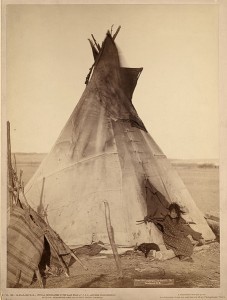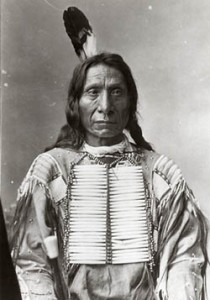Reservation Series: Pine Ridge
Enrolled Tribal Members: 46,885
People on the Reservation: 18,834
Programs Partnering with us: 79
Sovereign Nation Since: 1889
Official Tribal Web Site:
http://www.oglalalakotanation.org/
A Bit of Culture: Pine Ridge Reservation is second largest reservation in the U.S., with 1,775,413 acres. Pine Ridge is home to the Oglala Sioux Nation, whose traditional language is Lakota. Their traditional housing of mud wigwams or skin tipis was common among Plains tribes. The Oglala have a large Tribal Council, as well as Presidents that reside over the 9 “districts” on the reservation. The Oglala are known for both traditional and contemporary art forms, including beadwork and parfleche (painted rawhide).
A Bit of History: One famous Oglala Chief was Red Cloud. For two years, Red Cloud managed to close off the Bozeman Trail from attackers, which passed through prime buffalo hunting grounds and threatened the safety of their women and children. Red Cloud also worked to establish a school on Pine Ridge that is still in existence today; it was named the Red Cloud Indian School in his honor.
The Oglala Lakota are also tragically linked to the Wounded Knee Massacre of December 15, 1890. The revered Sitting Bull (Hunkpapa Sioux), others from his encampment, some Minneconjou Teton Sioux, and others had come together in Cherry Creek, SD (now on the Pine Ridge Reservation), where they joined Big Foot’s band of Minneconjou from Cheyenne River. (Big Foot is also known as Spotted Elk.) Sitting Bull was arrested. What ensued thereafter is unclear. Some say that on the day of the Wounded Knee massacre, Big Foot’s people were going to Red Cloud’s camp because they needed food and were caught by the Cavalry. Others say the Oglala were caught. What is clear is that on December 29, 1890, the 7th Cavalry trapped a small band of 300 Sioux men, women, and children near the Wounded Knee Creek. After taking away the group’s arms, the Calvary massacred every person they found – and left their bodies to freeze in the snow. As the story goes, only one infant girl who hid under a pile of bodies lived to tell about it. And to this day, only a small monument marks the names of the slain as proof of their existence. Wounded Knee has become the symbol for all of the atrocities, broken treaties, and injustices done to Native Americans past and present – and probably future – by the U.S. government.
The Land: The reservation is located mainly in Shannon County, which for years was the poorest county in the United States. Consistent with much of the Plains, the Pine Ridge Reservation is prairie land with prairie winds and mixed short and tall prairie grasses. In the winter, winds crossing the wide open prairie contribute to the extreme cold and blizzard conditions visited upon this region. Much of the fertile land is leased to cattle ranchers and farmers, and only a small portion of tribal members benefit from what is produced.
Current Economy: Most employment on the Pine Ridge Reservation is tribal- or government-based, such as the Oglala Lakota College (tribal), the Bureau of Indian Affairs (federal), and the U.S. Indian Health Service (federal). The Oglala Sioux Tribe owns some tourist-based businesses, including the Prairie Wind Casino and guided hunting. The tribe also has a ranching and farming operation.
In a recent report highlighted by MSN, SD is home to three reservations in the poorest counties in the nation, and Pine Ridge is one of those reservations. Pine Ridge now has a mid-sized grocery/hardware store to serve its population. Smaller stores on the reservation are often gas stations with expensive packaged foods. Residents often travel 130 miles to Rapid City to shop for fresh food and staples at lower prices. Discounts stores such as a Walmart or Target are non-existent on Pine Ridge as well as on most of the reservations we serve. Contaminated water is also a challenge in some communities. The intertribal, collaborative Mni Wiconi Project holds out promise to reconcile this, although budget cuts have delayed its progress. Many Elders also struggle to afford firewood to heat their homes. Others live with multiple generations in substandard and overcrowded housing.
Education & Income: The schools on Pine Ridge are challenged every year to retain their students and teachers. The teacher turnover rate is 8 times that of the national average, and the high school drop-out rate averages more than 70%. Unemployment on the reservation reaches 85%, depending on the community. More than half of the population is living below the federal poverty level, with some households subsisting on $3,400 to $3,700 per year.
Widespread poverty, day-to-day hardship, contaminated water, and lack of access take a toll on health too. Residents on the Pine Ridge Reservation have one of the shortest life expectancies of any group in the Western Hemisphere. The infant mortality rate is 5 times the national average. The teen suicide rate is 4 times the national average. The tuberculosis rate is 7 times the national average. The rate of cervical cancer is 5 times the national average. And nearly 50% of adults over the age of 40 have diabetes.
Quite possibly, the people of Pine Ridge have known more suffering directly related to poverty than any other group in North America. Yet despite these serious challenges, the Oglala Sioux remain strong in spirit and culture, and united as one of the most resilient groups ever to exist.
Learn More:
http://bit.ly/OglalaSioux
http://www.re-member.org/pine_ridge_reservation.aspx
http://www.accessgenealogy.com/native/tribes/siouan/oglalahist.htm
http://www.olc.edu/
http://www.sdtribalrelations.com/oglala.aspx




5 Comments
Most of the BIA Cops (bashing Indians around) that is exactly what they are good for. They too, as officers who should be examples have a drinking problem. Most are not trained well and most are abusive to their own people. Especially, to the women because of their power. They do not respect people with dignity and play favoritism. Even the judges who sit in Tribal courts play favoritism and employ their own family members. This includes the PD. They also are guilty of playing favoritism. Judges that have been sitting in Tribal Courts have problems with their own family members. Example: Sex abuse. This is serious and needs to be looked into. So are those in power immune from having to pay for their consequences to their behavior?Where do ethics come into play? Anonymous
Very interesting, I will bookmark this site and come back often. Thank you.
I feel sorry for all the different Indian tribes in the United States. You have been robbed,cheated,lied to from the first time you seen a white eye. I hope that things will get better for you and your people.
But Washington is not going to allow it,I think. Just look at the mine water spill on the Navajo reservation. People have been trying for years to get on that reservation to look for gold and silver. Now that uranium deposits are known to be there, I believe it is a way for Washington to get in there. So everyone be careful and watchful. May GOD ALMIGHTY smile on all the NATIVE AMERICAN PEOPLE.
Congratulations, David. You are the winner of the DVD, “Bridge the Gap to Pine Ridge,†a tale of walking in Oglala shoes for just one day. Thank you for commenting and taking part of our “30-Day Spotlight on Native America†for American Indian Heritage Month. Would you mind emailing your physical mailing address to webmaster@nativepartnership.org? Or, you can message us on our Facebook Page at http://www.facebook.com/PWNA4Hope. I will make sure we get your DVD mailed out to you right away. Thank you – and congratulations – again!
Such an amazing people. Sadly as is true with all people there are those who would destroy their own for gain that is of no lasting value. I hope one day we can all heal. There is so much knowledge and vast skills that we will lose and one day we will need that knowledge. We need the people to be strong! And the future generations need all they have to contribute. Most of all we need the young. And they need HOPE to survive.